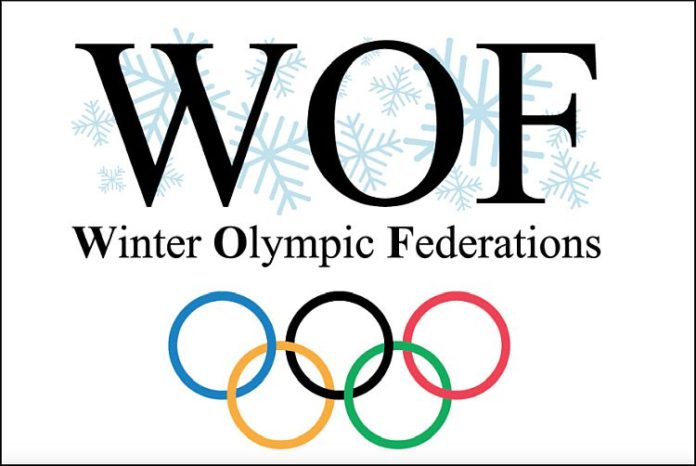★ The Sports Examiner: Chronicling the key competitive, economic and political forces shaping elite sport and the Olympic Movement.★
★ To get the daily Sports Examiner Recap by e-mail: sign up here! ★
≡ WINTER IFs ARE WORRIED ≡
“The Winter Olympic Federations believe, however, that the future of the Olympic Winter Games is not better served by piecemeal proposals, such as the inclusion of Summer IF’s non-Olympic disciplines into the Olympic Winter Games.
“The Winter Olympic Federations are firm in our belief that such an approach would dilute the brand, heritage, and identity that make the Olympic Winter Games unique – a celebration of sports practised on snow and ice, with distinct culture, athletes, and fields of play.”
That’s from a statement issued Wednesday by the Winter Olympic Federations group, the umbrella organization made up of the seven International Federations – for biathlon, bobsled & skeleton, curling, ice hockey, luge, skiing & snowboard and skating – which make up the permanent program of the Olympic Winter Games.
It started with:
“The Winter Olympic Federations are fully committed to innovation, universality, and strengthening the special and clearly differentiated appeal of the Olympic Winter Games.
“In this context, we fully support and greatly appreciate the opportunity created by the IOC President, Kirsty Coventry [ZIM], to review all aspects of the Olympic Movement through the Fit for the Future consultation process. This process invites a wide range of ideas from diverse stakeholders to set a coherent, long-term direction for the Olympic Movement.
“We applaud the IOC’s efforts to continue to modernize the Games in order to engage new audiences, and to explore dynamic and relevant ways to make the Olympic Movement more inclusive yet more sustainable.”
This is about money and exposure.
The specific threat to these winter-sport federations is a push from World Athletics and the Union Cycliste Internationale (UCI) to add sports traditionally held in the winter months, specifically cross country running and cyclo-cross.
In February 2025, French Alps 2030 President Edgar Grospiron (FRA) said that such events were on the long list of proposed additional sports that the organizing committee would consider:
“We will work calmly and study everything on the table with ski mountaineering, speed skiing, telemark, even cross-country or cyclo-cross and why not ice-cross? Afterwards, we will have to budget.”
World Athletics President Sebastian Coe (GBR) said in an October interview that he’s optimistic about the additions:
“I think there’s a good chance it’ll happen. And I think it’s come at the right moment, because Kirsty is certainly prepared to think differently about the programme, and what could go out of the stadium, and that mix between winter and summer. …
“I’ve always wanted to see cross-country back in for all sorts of reasons. Some are emotional. But it also gives Africa a proper presence in the winter Games, which, if we are being honest, it doesn’t really have.
“And sharing the same course in 2030 with cyclocross is really where our thinking is going. We’ve already had good conversations.
“[UCI President David Lappartient is] up for it. I’m up for it. Obviously with the IOC there would have to be a variation in the Charter, because it has to be with snow and ice, and there’s not been an obvious abundance of that recently. But it is, ostensibly, a winter sport, and cross-country would make more sense in the winter.”
And the existing winter federations are worried. Their statement included this from International Bobsled & Skeleton Federation President Ivo Ferriani (ITA):
“Innovation should focus on evolving existing winter sports to attract broader participation and audiences while enhancing the appeal of the Olympic Winter Games.
“A successful example of such evolution is the inclusion of Ski Mountaineering (ISMF), a discipline born from authentic winter environments and emblematic of the continued development of winter sports.”
The ISMF, which is making its Olympic debut at Milan Cortina 2026 is a microscopic federation whose inclusion will barely dent the amounts now paid to the winter federations from the IOC as a share of the television rights sales.
For multiple Winter Olympiads now, the IOC has distributed television rights shares to the seven winter federations in two tiers:
● Tier one (3) is the International Ice Hockey Federation, International Ski & Snowboard Federation, and the International Skating Union, recently about $40-42 million each per Games.
● Tier two (4) are the International Biathlon Union, International Bobsled & Skeleton Federation, World Curling and Federation Internationale de Luge, recently about $20-22 million each per Games.
Payouts from the IOC to the winter federations have been steady since 2010:
● $209 million from Vancouver 2010
● $199 million from Sochi 2014
● $215 million from PyeongChang 2018
● $201 million from Beijing 2022
Simply put, the winter federations see no reason to share any of this money with World Athletics or the UCI (which already receive Olympic Games television rights shares). And they have now – politely, but firmly – said so.
World Athletics and the UCI will counter that the inclusion of their sports will expand the universality of the Winter Games, not only in terms of participation, but also viewership and therefore, television rights in the future.
Too bad that Tug of War – last seen in Antwerp in 2020 – is no longer a part of the Olympic program, summer or winter.
¶
★ Receive our exclusive, weekday TSX Recap by e-mail by clicking here.
★ Sign up a friend to receive the TSX Recap by clicking here.
★ Please consider a donation here to keep this site going.
For our updated, 850-event International Sports Calendar for 2025, 2026 and beyond, by date and by sport, click here!



























